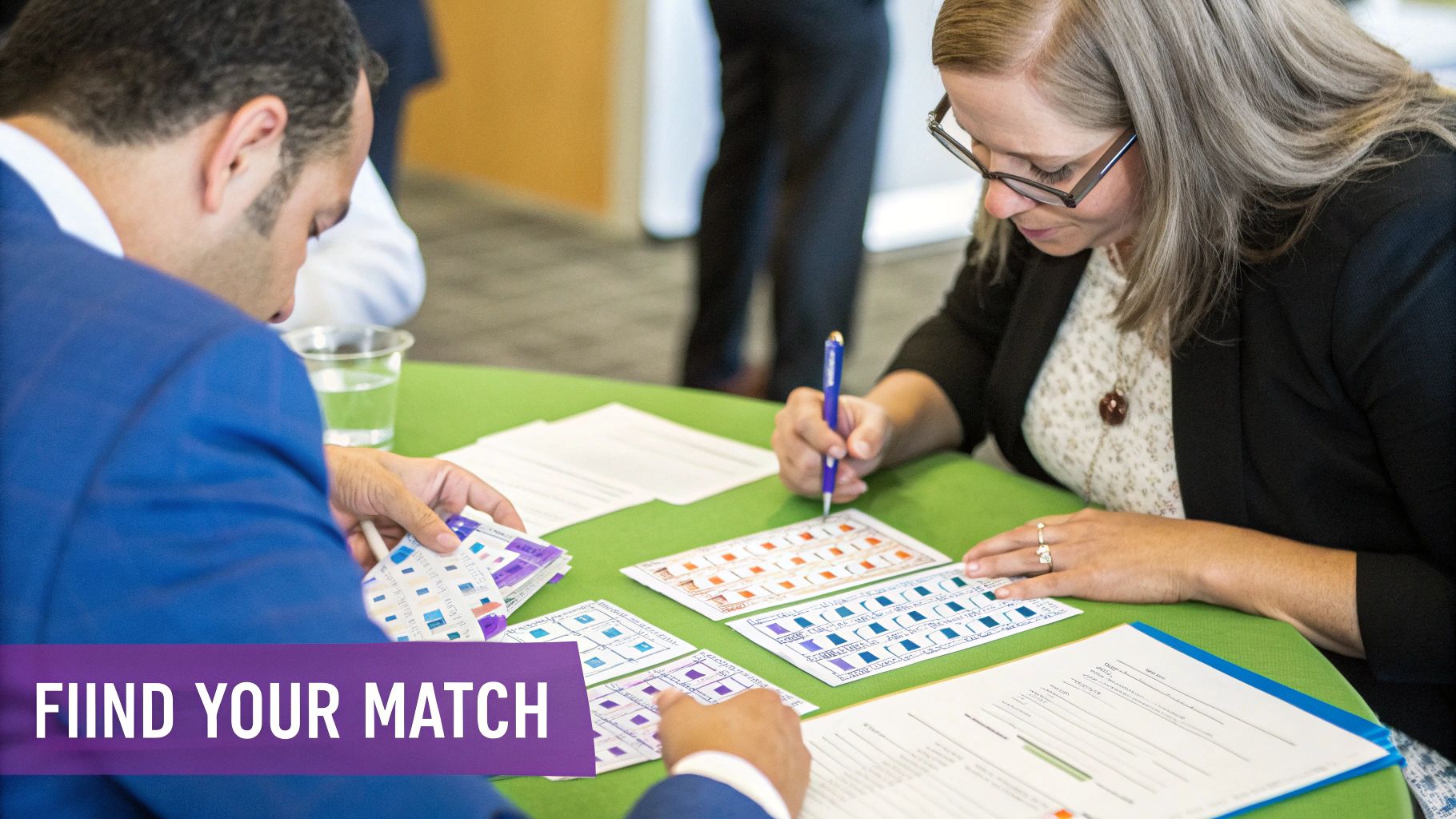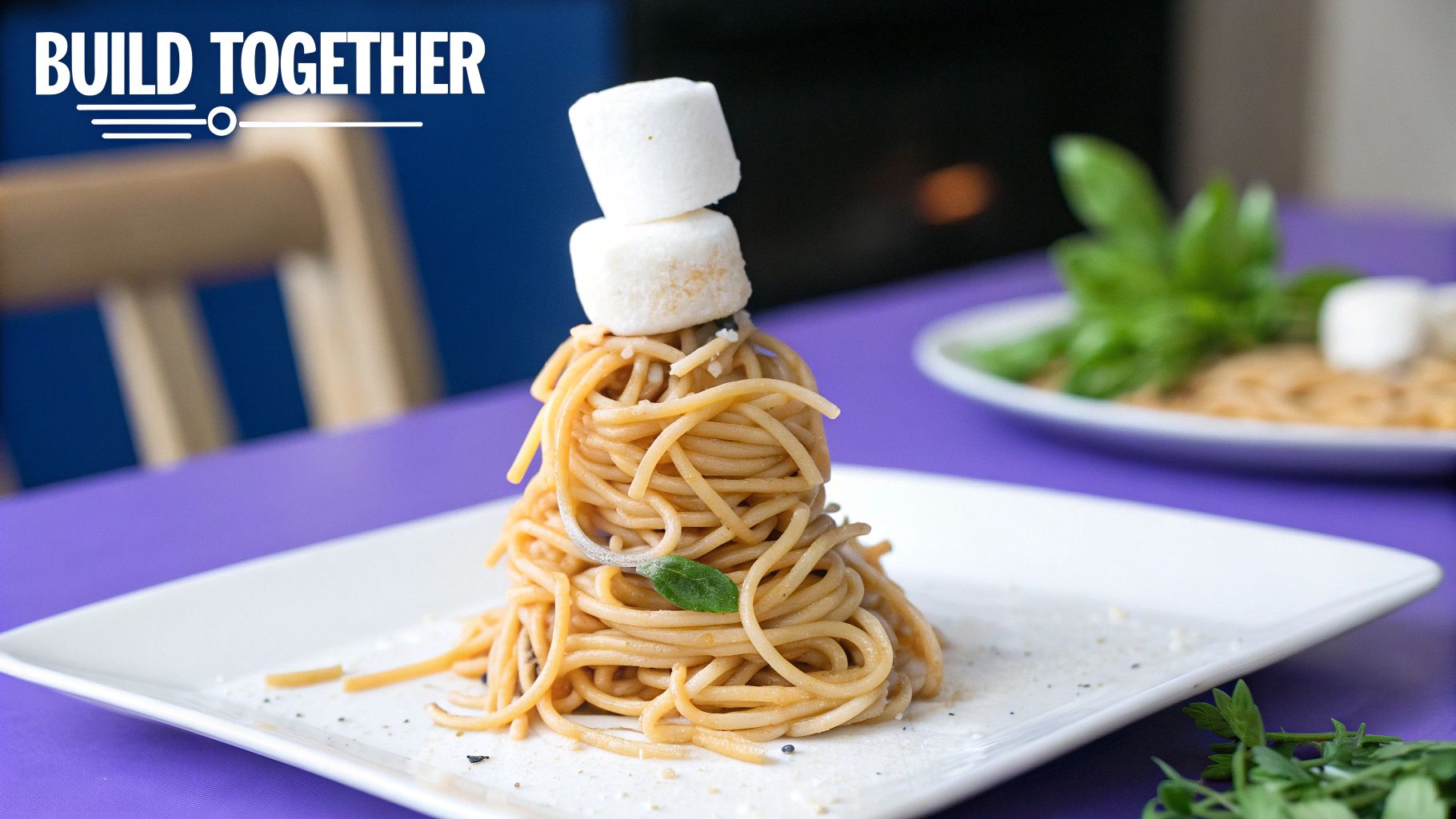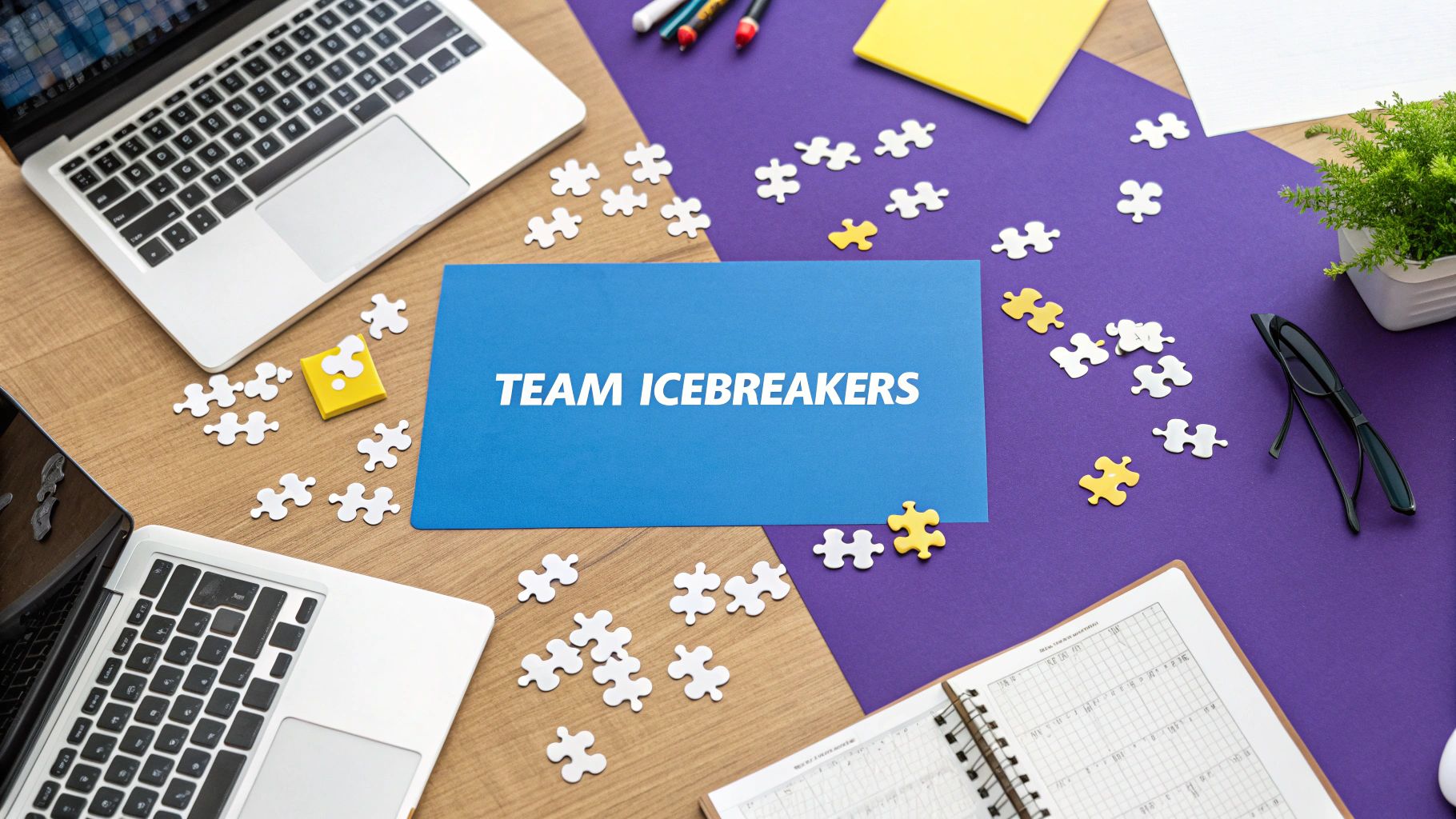In today's hybrid and remote work landscape, building a cohesive team can feel more challenging than ever. The casual conversations that once sparked camaraderie by the coffee machine have been replaced by scheduled video calls and instant messages. This is where the right icebreakers for team building become not just a 'nice-to-have' but a critical tool for fostering psychological safety, boosting collaboration, and reigniting team spirit.
Forget the cringeworthy, generic exercises of the past. A well-chosen icebreaker can transform a stale meeting into an engaging session, uncover hidden talents, and build genuine connections that translate into better work. These activities are a small investment with a big return, laying the groundwork for more effective communication and a supportive team environment. To create truly cohesive teams, it's crucial to understand the value of shared experiences and fostering genuine connections. For an in-depth look at broader strategies, check out these Top Corporate Team Building Activities that can further strengthen your team's bonds.
This guide provides a curated list of proven, practical, and adaptable icebreakers designed to energize your team, whether you're in the same room or connecting across continents. We’ll dive into step-by-step instructions, expert tips for facilitation, and variations to keep your sessions fresh and effective, ensuring every team member feels seen, heard, and valued from the very start.
1. Two Truths and a Lie
This classic game is one of the most effective icebreakers for team building because it blends personal sharing with a fun, low-stakes guessing game. The premise is simple: each person prepares three "facts" about themselves. Two of these statements are true, and one is a lie.
Each team member shares their three statements, and the rest of the group votes on which one they believe is the lie. The activity is perfect for helping new teams get acquainted or for established teams to learn surprising new things about each other. It uncovers hidden talents, unusual life experiences, and unique hobbies in a structured and engaging way.

How to Implement It
- Preparation: Give everyone 2-3 minutes to quietly brainstorm and write down their three statements. Remind them to make the lie plausible and the truths surprising to increase the challenge.
- Sharing: Have participants share their statements one by one. To keep the flow moving, you can go around the room or call on people randomly.
- Guessing: After a person shares, allow the team to discuss and guess which statement is the lie. For virtual teams, use the chat feature or a polling tool to collect votes simultaneously.
- The Reveal: The speaker reveals the lie, often sparking follow-up questions and conversations about the truths. This is where the real team connection happens.
Tips for Success
- Go First: As the facilitator, model the game by sharing your own truths and a lie first. This sets the tone and demonstrates appropriate sharing boundaries.
- Encourage Creativity: Advise participants to avoid common or generic truths. The more unique the statements, the more memorable and engaging the activity will be.
- Focus on Follow-Up: After a lie is revealed, prompt a brief conversation about the interesting truths. A simple "Wow, you have to tell us more about that!" can turn a simple game into a genuine bonding moment.
2. Human Bingo
This highly interactive game is one of the most dynamic icebreakers for team building, as it gets people moving, talking, and actively seeking connections. The activity transforms a simple meet-and-greet into a mission-driven game. Each participant gets a bingo card filled with squares describing various traits, experiences, or hobbies (e.g., "Find someone who speaks more than two languages" or "Find someone who has visited another continent").
The goal is to mingle and find colleagues who match the descriptions on the card, getting them to sign the corresponding square. The first person to complete a row, column, or the entire card wins. This icebreaker excels at breaking down silos and encouraging one-on-one conversations that might not happen otherwise, making it a favorite for large events like conferences at Salesforce or cross-departmental mixers at Microsoft.

How to Implement It
- Preparation: Create custom bingo cards with a mix of professional and personal prompts. Ensure the squares are relevant and achievable for your specific group. Print the cards or share a digital version for remote teams.
- Mingle: Give participants 10-15 minutes to walk around the room (or join breakout rooms) and find people who match the squares on their card. Each square must be signed by a different person.
- Winning: The first person to get a "Bingo!" (a full line, horizontally, vertically, or diagonally) shouts it out and is declared the winner.
- Debrief: After the game, ask people to share the most interesting or surprising thing they learned about a colleague. This reinforces the connections made. For more ways to facilitate group interaction, check out these group ice breaking activities.
Tips for Success
- Customize the Cards: Tailor the bingo squares to your team's culture. Include a mix of work-related skills ("has coded in Python") and fun personal facts ("can play a musical instrument").
- Set a Time Limit: Keep the energy high by setting a clear time limit. This encourages quick, focused interactions rather than long, drawn-out conversations.
- Offer Small Prizes: Motivate participation by offering small, fun prizes for the winners. This adds a lighthearted competitive element to the game.
- Adapt for Virtual Teams: Use online bingo card generators and virtual breakout rooms to replicate the experience for remote and hybrid teams. Participants can "sign" squares by typing their names in a shared document.
3. The Marshmallow Challenge
The Marshmallow Challenge is a fast-paced, hands-on design exercise that brilliantly reveals a team's dynamics, problem-solving skills, and approach to collaboration. It’s one of the most insightful icebreakers for team building because it forces groups to innovate and iterate under pressure. The goal is simple: teams of three to five people have 18 minutes to build the tallest possible freestanding structure using 20 sticks of spaghetti, one yard of tape, one yard of string, and one marshmallow, which must sit on top.
This challenge, popularized by Tom Wujec’s TED talk, is used globally by organizations like Autodesk and Stanford's d.school to teach critical lessons in design thinking and teamwork. It’s an engaging way to observe how teams manage resources, plan, and execute a project in a highly compressed timeframe. The activity often highlights the hidden assumptions and ingrained patterns that can either help or hinder a team’s success.

How to Implement It
- Preparation: Divide the group into small teams (3-5 people). Provide each team with an identical kit: 20 sticks of spaghetti, one yard of tape, one yard of string, and one marshmallow.
- Instructions: Clearly explain the rules: build the tallest freestanding structure with the entire marshmallow on top. Emphasize that the 18-minute time limit is strict.
- The Challenge: Start a visible timer and let the teams begin. Observe the different approaches teams take, from detailed planning to immediate prototyping.
- The Reveal: When the time is up, have everyone step away from their structures. Measure the height of each valid structure (freestanding with the marshmallow on top) to determine the winner.
Tips for Success
- Emphasize Prototyping: Encourage teams to test their ideas early and often. A common failure is building the entire structure before adding the heavy marshmallow at the last second, only to watch it collapse.
- Lead a Strong Debrief: The real value comes from the post-challenge discussion. Ask questions like, "What was your strategy?" and "What would you do differently?" Discuss the well-documented finding that kindergarteners often outperform business students because they prototype instead of just planning.
- Focus on Collaboration: Use the exercise to highlight the importance of different roles and communication styles within a team. This activity serves as an excellent foundation for more group activities to build teamwork.
4. Speed Networking/Speed Meeting
Inspired by speed dating, this activity uses a series of brief, timed, one-on-one conversations to efficiently connect team members. It is one of the most dynamic icebreakers for team building, especially for larger groups or new teams where individuals might not otherwise interact. Participants pair up for short chats (typically 2-5 minutes) before a signal prompts them to rotate to a new partner.
This structured format guarantees that everyone gets a chance to speak with multiple colleagues, breaking down silos and accelerating relationship-building. It's highly effective for everything from onboarding new hires to helping different departments, like those at Accenture, share knowledge. The rapid pace keeps energy high and conversations focused, making it a powerful tool for building a well-connected team.

How to Implement It
- Preparation: Arrange chairs in two rows facing each other or in concentric circles. Prepare a list of simple conversation prompts to guide the discussions.
- Pairing Up: Have participants sit down and pair up with the person across from them. Explain the rules: each round will last a set amount of time, and then one row or circle will rotate.
- Conversation Rounds: Announce the first prompt and start the timer. Use a bell or music to signal the end of the round. Have one line of participants shift one seat to the left or right to meet their next partner.
- Wrap-Up: After several rounds, end with 10-15 minutes of open mingling. This allows people to continue interesting conversations they started during the timed sessions.
Tips for Success
- Provide Prompts: Don't leave conversations to chance. Offer a mix of professional ("What's a recent win on your project?") and personal ("What's the best book you've read this year?") questions for each round.
- Manage Time Carefully: Use a clear audio signal for rotations and allow 30 seconds for transitions. For virtual teams, use breakout rooms with automatic timers. Check out these virtual icebreaker activities for more remote-friendly ideas.
- Encourage Note-Taking: Provide small notepads and pens so participants can jot down names and interesting details they want to remember about their new connections.
5. Desert Island Scenario
This imaginative exercise is one of the most versatile icebreakers for team building, revealing participants' priorities, problem-solving skills, and creativity in a fun, hypothetical context. The premise is simple: everyone is stranded on a desert island and can only bring a few items (typically 3-5) to help them survive and thrive.
Team members must explain the reasoning behind their choices, which sparks interesting conversations about practicality versus comfort or logic versus sentiment. This activity is fantastic for highlighting different ways of thinking and seeing how individual values align. It’s a low-pressure way to understand how teammates approach challenges, making it a favorite in everything from corporate retreats to virtual team kickoffs.
How to Implement It
- Preparation: Announce the scenario. To streamline the activity, provide a specific list of 10-15 items to choose from (e.g., a knife, a rope, a book, a solar charger, a magnifying glass). Alternatively, allow participants to choose any item they can imagine.
- Decision Time: Give everyone 2-3 minutes to individually select their items and think about their justifications. Setting a time limit adds a sense of urgency and encourages instinctual choices.
- Sharing and Explaining: Each person shares their chosen items one by one and explains why they selected them. This is the core of the activity, where personalities and priorities emerge.
- Group Discussion: After everyone has shared, you can facilitate a brief discussion about common choices or particularly creative solutions.
Tips for Success
- Use Themed Variations: Keep the activity fresh by changing the scenario. Instead of a desert island, try a "zombie apocalypse," a "mission to Mars," or surviving in a "post-apocalyptic city."
- Make it Collaborative: Turn it into a group challenge. Divide the team into smaller groups and ask them to reach a consensus on the three items they would bring together. This shifts the focus to negotiation and teamwork.
- Connect to Work: After the activity, bridge the fun back to the workplace. Discuss how the different problem-solving approaches revealed could be valuable for upcoming team projects.
6. Rose, Thorn, and Bud
This reflective exercise is one of the most powerful icebreakers for team building as it creates a space for vulnerability and empathy. The activity asks each person to share three things: a "rose" (a recent success or highlight), a "thorn" (a challenge), and a "bud" (an opportunity or something they are looking forward to).
This framework encourages meaningful sharing beyond surface-level updates. It helps teams understand each other’s current state of mind, celebrate wins, and acknowledge challenges in a structured, non-confrontational way. Popularized by design thinking and agile communities, it’s excellent for project retrospectives, weekly check-ins, or kicking off a problem-solving session with a dose of shared reality.
How to Implement It
- Preparation: Give team members a few moments to think about their rose, thorn, and bud. Define the scope, such as "over the past week" or "related to this project."
- Sharing: Go around the group and have each person share their three points. Keep each share brief, aiming for 1-2 minutes per person to maintain momentum.
- Acknowledge and Listen: The goal is not to solve the "thorns" immediately but to listen and build understanding. Create an atmosphere of active listening and support.
- Virtual Adaptation: For remote teams, use a virtual whiteboard tool like Miro or Mural. Have each person add their rose, thorn, and bud on digital sticky notes for a shared visual overview. This method is similar to other structured check-in questions for meetings.
Tips for Success
- Model Vulnerability: As the facilitator, go first to set the tone. Share a genuine thorn and bud to show that it’s safe for others to do the same.
- No Fixing Allowed: Explicitly state that the purpose of sharing a thorn is to be heard, not to have it solved on the spot. This prevents the session from turning into a problem-solving meeting.
- Make It a Ritual: Use this activity consistently, such as at the start of a weekly team meeting, to build it into your team's culture of open communication.
- Adapt the Metaphor: Keep it fresh by occasionally changing the prompt to "Peak, Pit, Plain" (a high point, a low point, and a normal event) or "High, Low, Hero" (a highlight, a challenge, and someone who helped).
7. The One-Word Icebreaker
This simple yet powerful activity is one of the most efficient icebreakers for team building, especially when time is short. It asks participants to answer a prompt, describe their mood, or express their hopes for a meeting using just a single word. The activity quickly surfaces the group’s collective mindset and creates a snapshot of the team's energy.
The beauty of the one-word icebreaker is its versatility. It can be used as a quick check-in to start a meeting, a way to set intentions for a project kickoff, or a tool to gauge audience energy at a large event. It requires minimal preparation and encourages participants to be concise and thoughtful, revealing deeper themes through simple choices.
How to Implement It
- Set the Prompt: Choose a clear and specific question. Examples include, "What is one word that describes your weekend?" or "What is your hope for this project in one word?"
- Share Simultaneously: For virtual teams, have everyone type their word into the chat but wait to press send until you give a countdown. This "chat waterfall" reveals all answers at once and prevents groupthink.
- Create a Visual: Use a tool like Slido or Mentimeter to collect words and instantly generate a visual word cloud. This highlights common themes and creates a shared artifact for the team.
- Discuss and Elaborate: Ask a few individuals to briefly explain their word choice, especially if it’s an unusual or intriguing one. This can spark meaningful, focused conversations.
Tips for Success
- Use It as a Bookend: Start a meeting with a one-word check-in (e.g., "mood") and end it with another (e.g., "takeaway"). This provides a clear measure of the session's impact.
- Be Specific with Prompts: Vague prompts lead to vague answers. A prompt like "Describe our team culture in one word" yields more insightful responses than "How are you?"
- Track Patterns Over Time: If used consistently in recurring meetings, you can track the words over several weeks to identify subtle shifts in team morale, project confidence, or overall energy.
8. Common Ground
This collaborative activity is one of the most powerful icebreakers for team building because it directly focuses on connection and shared identity. The goal is simple: pairs or small groups work together to find a list of things they have in common, moving beyond superficial similarities to discover truly unique shared experiences.
The exercise is designed to break down barriers and reveal unexpected connections that strengthen relationships. It’s particularly effective for diverse or newly formed teams, as it highlights that even people with different backgrounds often share common values, hobbies, or life events. This process builds empathy and establishes a foundation of mutual understanding.
How to Implement It
- Preparation: Divide the main group into pairs or small teams of three to four people. For virtual teams, use breakout rooms. Set a timer for 5-10 minutes.
- The Task: Instruct each group to create a list of at least 5-10 things all its members have in common. Challenge them to avoid obvious work-related points like "we all work at [Company Name]."
- Sharing: Once the time is up, bring everyone back together. Ask each group to share their most surprising or interesting commonality with the larger team.
- Discussion: The shared discoveries often lead to natural conversations and follow-up questions, reinforcing the bonds formed during the activity.
Tips for Success
- Set a Minimum: Require a specific number of commonalities (e.g., 10) to encourage groups to dig deeper than surface-level answers.
- Use Prompts: To guide the discovery process, you can provide prompts like, "Find a shared travel experience," "Discover a common childhood memory," or "Identify a similar personal value."
- Go First: As the facilitator, you can demonstrate by quickly finding one commonality with an attendee to show how easy it is to start.
- Share the Unexpected: The real magic happens when groups share their findings. Hearing that three colleagues all had the same first-ever concert or share a love for a niche hobby creates memorable team moments.
9. Would You Rather
This classic decision-making game is one of the most versatile icebreakers for team building, easily adaptable for any group or setting. The premise involves posing a hypothetical question with two distinct choices. Participants must pick one option and, more importantly, explain their reasoning, sparking lighthearted debates and revealing personality traits.
The game is excellent for stimulating creative thinking and understanding how different team members approach problems. By mixing fun, absurd scenarios ('Would you rather have hands for feet or feet for hands?') with more thought-provoking, work-related dilemmas, you can uncover team values, priorities, and decision-making styles in a low-pressure environment. It's a fantastic way to encourage participation from everyone, including quieter team members.
How to Implement It
- Preparation: Prepare a list of 5-10 "Would You Rather" questions. Start with easy, fun questions to warm up the group before moving to more complex or work-related scenarios.
- Posing the Question: Present one question to the group. For in-person teams, you can ask people to physically move to different sides of the room to represent their choice. For virtual teams, a polling feature works perfectly.
- Discussion: Ask for a few volunteers from each side to share the "why" behind their choice. This is where the real value lies, as the reasoning often reveals more than the choice itself.
- Facilitate Debate: Encourage a brief, friendly debate between the two sides. Keep it timed and focused to ensure the activity moves along smoothly.
Tips for Success
- Mix It Up: Blend silly, imaginative questions with practical, work-related ones. This keeps the energy high while also providing opportunities for professional insight.
- Encourage Justification: The goal is not just to choose but to explain. Prompt participants with "Tell us more about why you chose that" to encourage deeper sharing.
- Make It Physical: For in-person sessions, having team members move to a side of the room adds a dynamic physical element that increases engagement.
- Keep It Inclusive: Ensure your questions are appropriate for a professional setting and won't make anyone uncomfortable. As you explore more remote-friendly icebreakers, you will find more great ideas to adapt. Learn more about virtual icebreaker variations on remotesparks.com.
Icebreaker Activity Comparison Matrix
| Activity | Implementation Complexity 🔄 | Resource Requirements ⚡ | Expected Outcomes 📊 | Ideal Use Cases 💡 | Key Advantages ⭐ |
|---|---|---|---|---|---|
| Two Truths and a Lie | Low – simple rules, minimal prep | None | Improved team bonding, creativity, conversation | Small groups (5-20), new or forming teams | Breaks social barriers, engaging, versatile |
| Human Bingo | Medium – requires customized bingo cards | Prepared cards, physical space | Enhanced interaction, uncover skills, energizing | Medium-large groups (15-100), conferences/events | Forces mingling, uncovers talents, customizable |
| The Marshmallow Challenge | High – materials, prep, physical setup | Spaghetti, tape, string, marshmallow | Reveals team dynamics, collaboration, innovation | Teams (12-30) focused on problem-solving | Creative, teaches iteration, fun and memorable |
| Speed Networking | Medium – timed rotations, facilitation needed | Timer, space or virtual breakout rooms | Efficient connections, reduces networking anxiety | Groups (10-40), networking events | Systematic meet-everyone, good for introverts |
| Desert Island Scenario | Low – hypothetical scenario, discussion based | None | Reveals values, promotes creativity and reasoning | Small teams (5-20), early meeting or workshop | No materials, adaptable, encourages justification |
| Rose, Thorn, and Bud | Low-medium – structured sharing format | None or virtual whiteboards | Builds empathy, offers balanced reflection | Established teams, retrospectives, check-ins | Promotes psychological safety, vulnerability |
| The One-Word Icebreaker | Very Low – extremely quick and simple | None or simple tools (polls, chat) | Quick mood check, surfacing team sentiment | Any size, quick check-ins, meeting openings | Fast, low pressure, easy virtual adaptation |
| Common Ground | Low-medium – discussion and discovery | None | Strengthened connection, reveals shared traits | Diverse or new teams (6-30) | Builds belonging, good for diverse or siloed teams |
| Would You Rather | Low – simple questions, minimal setup | None or polling tools | Reveals values, encourages fun debate | Any size, energizing or lightening meetings | Engaging, humorous, easy virtual adaptation |
From Icebreakers to Breakthroughs: Building a Stronger Team
We've explored a diverse toolkit of icebreakers for team building, from the lighthearted fun of Two Truths and a Lie to the collaborative problem-solving of The Marshmallow Challenge. The activities in this guide, including Human Bingo, Desert Island Scenario, and Common Ground, are more than just meeting starters; they are strategic tools designed to dismantle barriers and build bridges within your team. The true power of these exercises lies not in the activity itself, but in the intentional space they create for authentic human connection.
The key takeaway is that an icebreaker’s effectiveness hinges on its alignment with your team’s context and goals. A quick One-Word Icebreaker might be perfect for a daily stand-up, while a more structured Speed Networking session is ideal for kicking off a new project. Remember that the goal is to foster psychological safety, a critical ingredient for high-performing teams. When team members feel safe to share, be vulnerable, and even fail together in a low-stakes environment, they are far more likely to bring their best, most innovative ideas to the table.
Turning Moments into Momentum
So, what are your next steps? Don't just bookmark this article. The real value comes from putting these ideas into practice.
- Start Small: Choose one icebreaker that resonates with you and commit to using it at your next team meeting. Observe how the team responds and what kind of conversations it sparks.
- Be Intentional: Match the icebreaker to the meeting's purpose. Are you trying to energize the group, encourage creative thinking, or get to know new members? Selecting the right tool for the job makes all the difference.
- Gather Feedback: After the session, ask your team what they thought. A simple, "What did you enjoy about that activity?" can provide valuable insights for future sessions and demonstrates that you value their experience.
By consistently integrating these simple practices, you shift from just "doing" icebreakers to strategically building a culture of connection. These small, repeated actions accumulate over time, strengthening relationships and fostering a more resilient, collaborative, and engaged team. As you grow more comfortable with these activities, you might find yourself incorporating them into larger team-building initiatives. For those looking to scale these efforts, effective resources for planning successful corporate events can help you create impactful in-person or hybrid experiences where these icebreakers can truly shine.
Ultimately, the journey from a group of individuals to a cohesive team is built on a foundation of shared experiences and mutual understanding. The icebreakers for team building discussed here are your building blocks. Use them to create moments of laughter, discovery, and connection. Those moments are the very sparks that ignite team breakthroughs.
Ready to move beyond connection and straight into collaborative innovation? Bulby uses AI-powered, structured brainstorming exercises to help your team generate better ideas, faster. Turn the trust you've built with icebreakers into tangible results with a proven framework for creativity.

